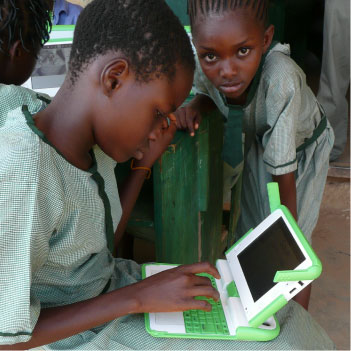OLPC: How do we gauge success? Will 490,000 units do?

The One Laptop per Child project's "Give One, Get One" program has been extended through Dec. 31 as donations averaged about $2 million a day. On that pace, the OLPC should move about 490,000 units by the end of the year. Does that make the effort a success?
The initial Give One, Get One promotion--a philanthropic sale if you will--began on Nov. 12 and 
In a statement on Thanksgiving, Nicholas Negroponte, founder of the One Laptop per Child initial promotion will be extended to the end of the year. The rationale: OLPC (blog focus, all resources) got good demand and some folks had asked for more time to organize groups. XO laptops, the flagship model of the OLPC project, can be bought for educational purchases in quantities of 100-999 at $299 each, 1000-9999 at $249 each, and 10,000 and up at $199 each. That scale means that if you buy 10,000 XOs in the Give One, Get One program you can hit the $100 barrier per laptop, the OLPC's initial price target.
Negroponte said:
“In the past 10 days, we’ve experienced an outpouring of support from the public that is truly gratifying and encouraging. Because so many people have asked for more time to participate either individually or in order to organize local and national groups to which they belong, we have decided to extend Give One Get One through the end of this year. During this extended period we will solicit input and transition to a program of giving only at the beginning of 2008. We want as many people as possible to have the opportunity to act upon the giving spirit of the holiday season.”
But the real kicker here is that donations to the Give One, Get One program have averaged $2 million a day. That figure allows us to come up with some rough estimates to gauge units. Consider:
- $2 million a day equates to a little more than 10,000 XO laptops a day at $200 each.
- Over 14 days (the two week period the promotion would have ran), OLPC has sold roughly 140,000 units. In other words, 70,000 units would go to developing nations.
- If that 10,000 unit a day pace is maintained through the end of the year (35 days), OLPC will sell another 350,000 units for a grand total of 490,000 under the extended Give One, Get One program. This guesstimate could be high or low depending on two factors--Christmas demand may spike and then fall off and it's unclear how many bulk orders will be donated.
So what's success here? My take is Negroponte's project is a success simply because it brought an issue to the forefront and got tech giants on board. If the Classmate is a developing world hit, you can thank OLPC. But that's just my take. Here are a few variables to weigh to make your own decision:
- Mass production has just begun and the first run is roughly 300,000 laptops. It's possible that the OLPC project gains momentum, but it appears that Negroponte's initial goal of 150 million users by the end of 2008 is impossible.
- However, 490,000 units by the end of 2007 isn't chump change. That means 245,000 units will go to the developing world. That's a helluva lot more than you and I could do.
- The OLPC ripple effect. Microsoft is giving Windows away for $3 to battle Linux in emerging markets. Intel has created a solid educational PC with the Classmate and Christopher Dawson gives it rave reviews. Would either of these moves have happened without Negroponte's big idea (a cheap Linux laptop with an AMD chip)? I'd argue no. Just the thought of Linux being ported to kids everywhere was enough to spur Microsoft into action. Intel sped up its plans. Putting Linux-Windows religious wars aside, these developments can't be bad.
In other words, these variables don't necessarily add up into a definitive answer. If you're a slave to numbers and units, the OLPC isn't up to snuff yet. If you look at the impact OLPC had on rivals perhaps the project is successful even if it doesn't sell another laptop.
But the real success story will depend on other factors. A few of these factors include:
- OLPC support and training in developing nations: Can the OLPC match the resources of Intel and Microsoft?
- U.S. purchases: Once this Give One, Get One promotion ends will the donations continue? My hunch is the slowdown will be dramatic. In fact, I wouldn't be surprised if the Give One, Get One promotion becomes the permanent model as techies bankroll PC shipments to the developing world.
- Infrastructure: Will the XO laptop be as successful without a hotspot or Internet connection? The infrastructure in these developing markets is nil. Is the XO good enough educationally without a Web connection?
Simply put, the OLPC tale is still being written, but rest assured the success or failure debate will probably heat up.